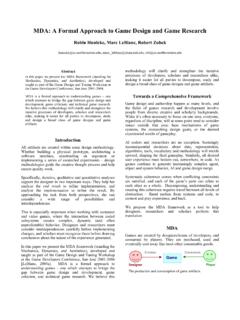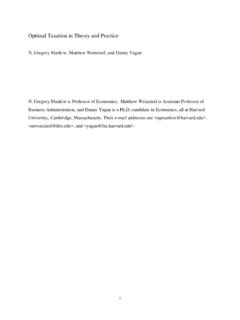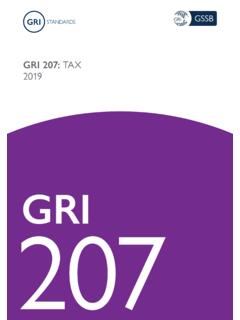Transcription of 3. Handbook on Show Cause Notice - Approach and Reply ...
1 Handbook on Show Cause Notice - Approach and Reply under GST The Institute of Chartered Accountants of India (Set up by an Act of Parliament) New Delhi The Institute of Chartered Accountants of India All rights reserved. No part of this publication may be reproduced, stored in a retrieval system, or transmitted, in any form, or by any means, electronic, mechanical, photocopying, recording, or otherwise without prior permission, in writing, from the publisher. DISCLAIMER: The views expressed in this book are of the author(s). The Institute of Chartered Accountants of India may not necessary subscribe to the views expressed by the author(s). The information contained in this book has been drawn primarily from the and other sources. While every effort has been made to keep the information in this book error free, the Institute or any office of the same does not take the responsibility for any typographical or clerical error which may have crept in while compiling the information.
2 First Edition : August, 2020 Committee/Department : GST & Indirect Taxes Committee E-mail : Website : ; Price : `50 /- ISBN : 978-81-8441- Published by : The Publication Department on behalf of the Institute of Chartered Accountants of India, ICAI Bhawan, Post Box No. 7100, Indraprastha Marg, New Delhi - 110 002. Printed by : Sahitya Bhawan Publications, Hospital Road, Agra - 282 003. 3 Foreword The introduction of Goods & Services Tax (GST) in India is one of the most significant indirect tax reforms since Independence. The reform that took more than a decade of mutual co-operation, continuous discussion and intense debate between Central and State Governments about implementation methodology, was finally implemented with effect from 1st July 2017, subsuming almost all indirect taxes at the Central and State levels.
3 As the journey of GST implementation progressed in India, the authorities have been quick to address the various challenges faced by the Industry and public concerns by issuing a series of notifications, clarifications, press releases and FAQs, to resolve a wide range of concerns. The GST along with its challenges has brought in various benefits also like creation of National market by bringing down fiscal barriers amongst the States and has mitigated the cascading effect of taxes by allowing seamless credit of input tax across goods and services. The Institute of Chartered Accountants of India (ICAI) through its GST & Indirect Taxes Committee has been playing a vital role in the implementation of GST in India by providing suggestions to the Government at each stage of development of GST. Further, the Institute has been playing proactive role and is a catalyst in dissemination of knowledge and awareness through technical publications, newsletters, e-learning and organizing various programmes, Certificate courses, webcasts etc.
4 For all stakeholders. I am happy to note that the GST & Indirect Taxes Committee of ICAI has now taken an initiative to issue a series of Handbooks covering various procedural aspects of GST and in that series is bringing out this Handbook on Show Cause Notice - Approach and Reply under GST with an objective to provide a basic understanding of the topic. The Handbook explains the concepts / procedures relating to Show Cause Notices - Approach and Reply thereto in an easy to understand lucid language and it is aimed at updating the knowledge base of members in a simple and concise manner. I congratulate CA. Rajendra Kumar P, Chairman, CA. Sushil Kumar Goyal, Vice-Chairman and other members of GST & Indirect Taxes Committee for coming out with this Handbook and for taking active steps in providing regular guidance to the members and other stakeholders at large.
5 I am sure that Members will find this publication very useful in discharging the statutory functions and responsibilities in an efficient and effective manner. CA. Atul Kumar Gupta President, ICAI Date: 4th August, 2020 Place: New Delhi Preface Goods and Services Tax (GST) was introduced in India from 1st July, 2017. It is one of the major tax reforms since independence in the area of indirect taxation. It was introduced with the objective to mitigate the cascading effect of taxes by allowing seamless credit across goods and services, facilitate free flow of goods and services across India and boosting tax revenue from better compliance and widening the tax base. A remarkable feature of GST implementation is that all the States in India came together with the Centre to form a unique federal body called GST Council, which is entrusted with the objective of recommending policies and procedural matter in the formation and implementation of GST legislation.
6 The spirit of co-operative federalism took deep roots thereby ensuring that large federal countries like India implement the GST Law. In order to facilitate understanding the various compliances under GST, the GST & Indirect Taxes Committee of ICAI has taken an initiative to prepare a Handbook on procedural aspects like registration, refund, return, Invoice etc. One of the results of such initiative is this Handbook on Show Cause Notice - Approach and Reply under GST. An attempt has been made herein to cover all aspects related to Show Cause Notices - Approach and Reply thereto at one place and is intended to give general guidance to all stakeholders and also help them in resolving issues that they may face during the course of their compliance aspect in GST. This Handbook on Show Cause Notice - Approach and Reply under GST is comprehensive containing analysis of the entire provisions under the law including notifications, circulars or orders upto 31st July, 2020 issued by the Government from time to time along with few FAQ s, MCQ s, Flowcharts, Diagrams and Illustrations etc.
7 To make the reading and understanding easier. We stand by the Government in our role as Partners in GST Knowledge Dissemination and have always been supporting Government with our intellectual resources, expertise and efforts to make GST error-free. We sincerely thank CA. Atul Kumar Gupta, President and CA. Nihar Niranjan Jambusaria, Vice-President, ICAI for their encouragement to the initiatives of the GST & Indirect Taxes Committee. We express our gratitude for the untiring effort of CA. N K Bharath Kumar who has shared his intellectual expertise and CA. A. Jatin Chrostopher for reviewing this publication. We place on record the services and unstinted support provided by the Secretariat of the Committee. We trust this Handbook will be of practical use to all the members of the Institute and other stakeholders. We also welcome suggestions at and request you to visit our website and provide valuable inputs in our journey to make GST truly a good and simple tax.
8 CA. Rajendra Kumar P Chairman GST & Indirect Taxes Committee CA. Sushil Kumar Goyal Vice- Chairman GST & Indirect Taxes Committee Date: 4th August, 2020 Place: New Delhi Contents 1. Introduction .. 1 2. Coverage .. 2 3. Show Cause Notice under Section 73 .. 3 4. Show Cause Notice under Section 74 .. 7 5. Show Cause Notice under Section 76 .. 12 6. Comparison between Notice under Section 73, 74 & 76 .. 14 7. General Provisions relating to Show Cause Notice under Section 75 .. 16 8. Manner of Service of Notice .. 20 9. What s next on Receipt of Show Cause Notice .. 22 Chapter 1 Introduction Show Cause Notice shortly called as SCN is a document served by the department on a person asking him to explain with reasons as to why a particular course of action should not be taken against him. It is similar to an opportunity given to a person who is proposed to be charged with violation of law by giving him sufficient opportunity to submit his view point as to why he should not be proceeded against for the alleged violation.
9 It is a time-tested principle of natural justice (audi alteram partem meaning let the other side be heard ) that no person can be adjudged guilty without being given an opportunity to answer charges against such person. And to hear a person, such person should be put at Notice which clearly states various aspects about the charges or allegations in such Notice so that the person can understand the allegations and answer them. In GST, as with every legislation, this Notice is called show Cause Notice and this show Cause Notice is a mandatory requirement for raising demands. Any other communication, letter, endorsement, suggestion or advisory from tax Department cannot be considered to be a show Cause Notice . It has also been held that, a Notice to show Cause has to be issued under specific sections of law with all the essential ingredients and Reply to such SCN submitted has to be considered by the adjudicating authority and only then, liability has to be determined by issuance of an order or adjudication also known as Order-in-Original.
10 Notice is thus a sine qua non for any demand proceedings and SCN is the one that sets the law in motion . Show Cause Notice is the foundation in the matter of recovery of duty, penalty and interest and if a particular point is not raised in the show Cause Notice , it cannot be raised later at any of the appellate stage(s). Show Cause Notice is a foundation on which the Department has to build its case. Hence, show Cause Notice is a basic and an indispensable part of proceedings in the tax system. Chapter 2 Coverage Under the Goods and Services Tax Law, there are multiple situations where we encounter the provision for issuance of show Cause Notice . These situations are as tabulated below. Situations Form 1 Denial of option to pay tax under Section 10 GST-CMP-05 2 For cancellation of regular registration GST-REG-17 3 For rejection of application for revocation of cancellation of registration GST-REG-23 4 For cancellation of provisional registration GST-REG-27 5 For disqualification of GST Practitioner GST-PCT-03 6 Rejection of refund claim GST-REF-08 7 Assessment under Section 63 GST-ASMT-14 8 Show Cause Notice under Section 73 9 Show Cause Notice under Section 74 10 Show Cause Notice under Section 76 In this booklet, we are going to cover show Cause Notice issued under Sections 73, 74 and 76 in particular.







